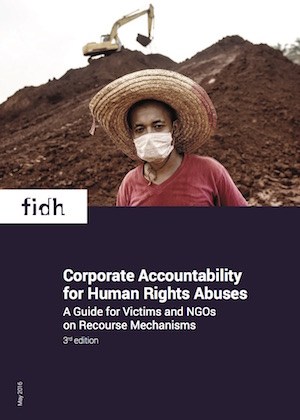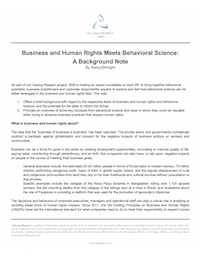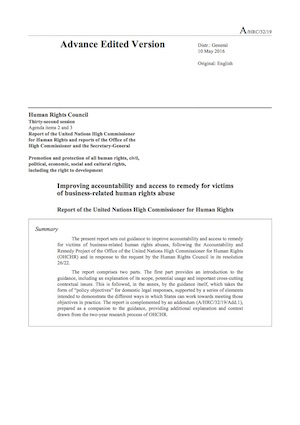The summary is excerpted from the resource.
Summary
With this guide, the International Federation for Human Rights (FIDH) seeks to provide a practical tool for victims, and their (legal) representatives, NGOs and other civil society groups (unions, peasant associations, social movements, activists) to seek justice and obtain reparation for victims of human rights abuses involving multinational corporations. To do so, the guide explores the different judicial and non-judicial recourse mechanisms available to victims.
In practice, strategies for seeking justice are not limited to the use of recourse mechanisms, and various other strategies have been used in the past. Civil society organisations have for instance set up innovative campaigns on various issues such as baby-milk marketing in Global South countries, sweatshops in the textile industry profiting multinationals or illicit diamond trafficking fuelling conflicts in Africa. Such actions have yielded results and can turn out to be equally (or even more) effective than using formal channels. While this guide will not focus on such strategies, they are often used alongside and reinforce the use of recourse mechanisms. The main focus of this guide is violations committed in third countries by or with the support of a multinational company, its subsidiary or its commercial partner. Hence, the guide focuses in particular on the use of extraterritorial jurisdiction to strengthen corporate accountability.
This guide does not address challenges specifically faced by small and medium-size enterprises. While all types of enterprise play a crucial role in ensuring respect for human rights, we focus on multinational groups. At the top of the chain, it is considered that they have the power to change practices and behaviours, that their behaviour conditions the rest of the chain and that they are in a position to influence their commercial partners, including small and medium-size enterprises. The guide is comprised of five sections. Each examines a different type of instrument.
The first section looks at mechanisms to address the responsibility of States to ensure the protection of human rights. International and regional intergovernmental mechanisms of quasi-judicial nature are explored, namely the United Nations system for the protection of human rights (Treaty Bodies and Special Procedures), the International Labour Organisation complaint mechanisms and regional systems for the protection of human rights at the European, Inter-American and African levels, including possibilities provided by African economic community tribunals.
The second section explores legal options for victims to hold a company liable for violations committed abroad. The first part analyses opportunities for victims to engage States’ extraterritorial obligations, e.g., to seek redress from parent companies both for civil and criminal liability. The section then goes on to explore the promising yet still very limited windows of opportunity within international tribunals and the International Criminal Court. The guide sets out the conditions under which courts of home States of parent companies may have jurisdiction over human rights violations committed by or with the complicity of multinationals. The obstacles that victims tend to face when dealing with transnational litigation — which are numerous and important — are highlighted. While this section does not pretend to provide an exhaustive overview of all existing legal possibilities, it emphasizes different legal systems, mostly those of the European Union and the United States. In addition to practical considerations, this choice is also justified by the fact that parent companies of multinational corporations are often located in the US and the EU (although many are now based in emerging countries); the volume of legal proceedings against multinationals head-quartered in these countries has increased; and, these legal systems present interesting procedures to hold companies (or their directors) accountable for abuses committed abroad.
The third section looks at mediation mechanisms that have the potential to address directly the responsibility of companies. With a particular focus on the OECD Guidelines for Multinational Enterprises and the National Contact Points countries set up to ensure respect of the guidelines, the section looks at the process, advantages and disadvantages of this procedure. The section also briefly highlights developments within National Human Rights Institutions and other innovative ombudsman initiatives.
The fourth section touches upon one of the driving forces of corporate activities: the financial support companies receive. The first part reviews complaints mechanisms available within International Financial Institutions as well as regional development banks that are available to people affected by projects financed by these institutions. Largely criticized by civil society organisations in the last decades, these institutions have faced increased pressure to adapt their functioning for greater coherence between their mandate and the projects they finance. Most of the regional banks addressed in this guide have gone through recent consultation processes and subsequent changes of their policies, standards and structure of their complaint mechanisms. Their use presents interesting potential for victims. The second part looks at available mechanisms within export-credit agencies, as public actors are being increasingly scrutinized for their involvement in financing projects with high risks of human rights abuses. Not forgetting the role private banks can play in fuelling human rights violations, the third part of this section addresses one initiative of the private sector, namely the Equator Principles for private banks. The fourth and last part of this section discusses ways to engage with the shareholders of a company. Shareholder activism is an emerging trend that may represent a viable way to raise awareness of shareholders on violations that may be occurring with their financial support. Even more important, the increasing attention paid by investors (in particular institutional investors) to environmental, social and governance criteria can be a powerful lever.
Last but not least, the fifth section explores voluntary initiatives set up through multistakeholder, sectoral or company-based CSR initiatives. As mentioned above, various companies have publicly committed to respect human rights principles and environmental standards. As far as implementation is concerned, a number of grievance mechanisms have been put in place and can, depending on the context, contribute to solve situations of conflict. Interestingly, such commitments may also be used, including through legal processes by victims and other interested groups such as consumers to ensure that companies live up to their commitments. This section provides an overview of such avenues.



